Bitumen Characteristics, Genesis, and Hydrocarbon Significance in Paleozoic Reservoirs: A Case Study in the Kongxi Slope Zone, Dagang Oilfield, Huanghua Depression
Abstract
1. Introduction
2. Geological Background
3. Methods
3.1. Thin Section and Fluorescence Analysis
3.2. Reflectance Measurements
3.3. Thermovaporization Gas Chromatography
3.4. Fourier Transform Ion Cyclotron Resonance Mass Spectrometry (FT-ICR MS)
3.5. Micro-Raman Spectroscopy
3.6. Thermal Experiments
3.7. SEM and EDS Analysis
4. Results
4.1. Occurrent States of Reservoir Bitumen
4.2. Maturity of Reservoir Bitumen
4.3. Geochemical Parameters of Reservoir Bitumen
4.3.1. Characteristics of Hydrocarbons
4.3.2. Characteristics of Non-Hydrocarbons
5. Discussion
5.1. Sources of Paleozoic Reservoir Bitumen
5.1.1. Geochemical Indicators of Crude Oil
5.1.2. Sources of Reservoir Bitumen
5.2. Reservoir Bitumen Thermal Simulation Experiments
5.3. Evolutionary Patterns of Reservoir Bitumen
5.4. Geological Significances
6. Conclusions
- (1)
- Bitumen in the Kongxi slope zone of the Dagang oilfield occurs as bands, veins, and dispersed deposits within fractures and pores. Petrographic analysis revealed black, non-fluorescent bitumen filling pores in carbonate and clastic rocks, often associated with fluorescent crude oil. Bitumen inclusions and dark brown bitumen components are also present in crude oil separates.
- (2)
- Reservoir bitumen formation in the Kongxi slope zone occurred in two stages: initial oxidative washing and biodegradation during Late Jurassic uplift, followed by thermal alteration during Cenozoic deep burial. The second stage was enhanced by carbonate mineral catalysis, generating both low-molecular-weight hydrocarbons and bitumen.
- (3)
- This evolution indicates multiple hydrocarbon charging events. While uplift destroyed some paleo-reservoirs, unexposed areas may contain preserved paleo-hydrocarbon accumulations. Post-Paleozoic light condensates from Carboniferous coal measures, showing limited thermal alteration, represent the primary exploration target.
Author Contributions
Funding
Data Availability Statement
Conflicts of Interest
References
- Yuan, G.; Cao, Y.; Sun, P.; Zhou, L.; Li, W.; Fu, L.; Li, H.; Lou, D.; Zhang, F. Genetic mechanisms of Permian Upper Shihezi sandstone reservoirs with multi-stage subsidence and uplift in the Huanghua Depression, Bohai Bay Basin, East China. Mar. Pet. 2021, 124, 104784. [Google Scholar] [CrossRef]
- Marzieh, H.K.; Omid, M.J.; Seyed, M.R.P.; Krzysztof, F.; Mohammad, R.S. Modification of thermal and rheological characteristics of bitumen by waste PET/GTR blends. Constr. Build. Mater. 2017, 134, 157–166. [Google Scholar]
- Huang, W.; Guo, Y.; Zheng, Y.; Ding, Q.; Sun, C.; Yu, J.; Zhu, M.; Yu, H. Chemical and rheological characteristics of rejuvenated bitumen with typical rejuvenators. Constr. Build. Mater. 2021, 273, 121525. [Google Scholar] [CrossRef]
- Abdul, M.M.; Muslich, H.S.; Madzlan, N.; Nur, I.M.Y.; Rizwan, A.M.; Abdulnaser, M.A.; Mujahid, A. Physicochemical, rheological and morphological properties of bitumen incorporating petroleum sludge. Constr. Build. Mater. 2021, 297, 123738. [Google Scholar]
- Jia, W.; Xiao, Z.; Yu, C.; Peng, P. Molecular and isotopic compositions of bitumens in Silurian tar sands from the Tarim Basin, NW China: Characterizing biodegradation and hydrocarbon charging in an old composite basin. Mar. Pet. Geol. 2010, 27, 13–25. [Google Scholar] [CrossRef]
- Åsa, L.L.; Viveca, W.; Björn, B. Adhesive surface characteristics of bitumen binders investigated by Atomic Force Microscopy. Fuel 2013, 113, 248–256. [Google Scholar]
- Paul, N.; Qi, L.; Murray, R.G. Role of water and fine solids in onset of coke formation during bitumen cracking. Fuel 2016, 166, 152–156. [Google Scholar]
- Jian, C.; Peng, P. A comparative study of free and bound bitumens from different maturesource rocks with Type III kerogens. Org. Geochem. 2017, 112, 1–15. [Google Scholar]
- Han, X.; Yu, J.; Huang, X.; Cao, Z.; Wang, R.; He, P. Preparation of reactive chain extension rejuvenators and its application in the aged SBS modified bitumen sustainable recycling. J. Clean. Prod. 2021, 314. [Google Scholar] [CrossRef]
- Huang, J.; He, W.; Lin, J.; Li, X.; Xu, Y.; Wang, Y.; Wang, H. Geochemical characteristics of bitumen from the Cambrian reservoir in the Ordos basin, Northern China: Insights into bitumen classification and origin. J. Asian Earth Sci. 2022, 230, 105168. [Google Scholar] [CrossRef]
- Kuo, J.; Tian, Y.; Jiang, J.; Yan, X.; Tian, J.; Wang, Z.; Zhang, J. The void characteristics of cement emulsified bitumen mixture under microwave heating by X-ray computed tomography. Constr. Build. Mater. 2024, 425, 136023. [Google Scholar] [CrossRef]
- Liu, C.; Gong, H.; Dun, C.; Wang, X.; Yang, Y.; Tong, C.; Zhang, Z. Anthraxolite Evolution and Vanadium Enrichment Mechanism in the Tanjianshan Group, Upper Ordovician in the Northern Qaidam Basin. Nat. Resour. Res. 2020, 29, 2127–2145. [Google Scholar] [CrossRef]
- Ma, A.L.; Zhang, S.C.; Zhang, D.J.; Lu, G.J. Ruthenium-ions-catalyzed oxidation of the asphaltenes of oils and oi-l source correlation in the Tarim Basin. Pet. Explor. Dev. 2004, 31, 54–58. [Google Scholar]
- Cheng, B.; Wang, T.-G.; Chen, Z.; Chang, X.; Yang, F. Biodegradation and possible source of Silurian and Carboniferous reservoir bitumens from the Halahatang sub-depression, Tarim Basin, NW China. Mar. Pet. Geol. 2016, 78, 236–246. [Google Scholar] [CrossRef]
- Gan, H.; Wang, H.; Shi, Y.; Ma, Q.; Liu, E.; Yan, D.; Pan, Z. Geochemical characteristics and genetic origin of crude oil in the Fushan sag, Beibuwan Basin, South China Sea. Mar. Pet. Geol. 2020, 112, 104114. [Google Scholar] [CrossRef]
- Fustic, M.; Bennett, B.; Adams, J.; Huang, H.; MacFarlane, B.; Leckie, D.A.; Larter, S. Bitumen and heavy oil geochemistry: A tool for distinguishing barriers from baffles in oil sands reservoirs. Bull. Can. Pet. Geol. 2011, 59, 295–316. [Google Scholar] [CrossRef]
- Jacob, H. Classification, structure, genesis and practical importance of natural solid oil bitumen (“migrabitumen”). Int. J. Coal Geol. 1989, 11, 65–79. [Google Scholar] [CrossRef]
- Lewan, M.D. Evaluation of petroleum generation by hydrous pyrolysis experimentation: Philosophical Transactions of the Royal Society of London. Ser. A Math. Phys. Sci. 1985, 315, 123–134. [Google Scholar]
- Stasiuk, L.D. The origin of pyrobitumens in upper Devonian Leduc formation gas reservoirs, Alberta, Canada: An optical and EDS study of oil to gas transformation. Mar. Pet. Geol. 1997, 14, 915–929. [Google Scholar] [CrossRef]
- Jiang, B.; Zhan, Z.-W.; Shi, Q.; Liao, Y.; Zou, Y.-R.; Tian, Y.; Peng, P. Chemometric Unmixing of Petroleum Mixtures by Negative Ion ESI FT-ICR MS Analysis. Anal. Chem. 2019, 91, 2209–2215. [Google Scholar] [CrossRef]
- Wang, T.G.; Wang, F.Y.; Lu, H.; Tang, Y.J. Oil source and formation period of Ordovician reservoirs in the Kongxi subduction zone of the Huanghua depression. Mar. Orig. Pet. Geol. 2000, 5, 47–54. [Google Scholar]
- Zhang, J.; Yang, P.X.; Pan, M.; Qi, J.F. Tectonic evolution of the Kongxi structural belt. J. Chengdu Univ. Technol. 2002, 29, 399–404. (In Chinese) [Google Scholar]
- Qi, J.F.; Zhang, Y.W.; Lu, K.Z.; Yang, Q. Genozoic tectonic evolution in Bohai Bay Basin Province. J. Univ. Pet. China 1995, 19, 1–6. (In Chinese) [Google Scholar]
- ASTM D2797/D2797M-11a; Standard Practice for Preparing Coal Samples for Microscopical Analysis by Reflected Light. ASTM International: West Conshohocken, PA, USA, 2015; 5p.
- ASTM D7708-23; Standard Test Method for Microscopical Determination of the Reflectance of Vitrinite Dispersed in Sedimentary Rocks. ASTM International: West Conshohocken, PA, USA, 2023.
- Wang, L.; Han, Y.; Lou, D.; He, Z.; Guo, X.; Steele-MacInnis, M. Hydrothermal petroleum related to intracontinental magmatism in the Bohai Bay Basin, eastern China. Mar. Pet. Geol. 2024, 167, 106982. [Google Scholar] [CrossRef]
- Han, Y.; Mahlstedt, N.; Horsfield, B. The Barnett Shale: Compositional fractionation associated with intraformational petroleum migration, retention, and expulsion. AAPG Bull. 2015, 99, 2173–2202. [Google Scholar] [CrossRef]
- Ma, Z.Y.; Zhang, L.; Zhu, X.C.; Zhu, X.X.; Huang, W. Characteristics and Genesis of Bitumen in Ordovician Reservoirsin Central Tarim Basin. Mar. Orig. Pet. Geol. 2014, 19, 19–24. (In Chinese) [Google Scholar]
- Yu, Y.; Sun, J.C.; Yu, Z.L.; Chen, D.R. Geochemical characteristics and oil source comparison of Paleozoic crude oil from the North Dagang Subduction Hill in the Huanghua depression. Inn. Mong. Petrochem. 2020, 46, 112–115. [Google Scholar]
- Ziegs, V.; Noah, M.; Poetz, S.; Horsfield, B.; Hartwig, A.; Rinna, J.; Skeie, J.E. Unravelling maturity- and migration-related carbazole and phenol distributions in Central Graben crude oils. Mar. Pet. Geol. 2018, 94, 114–130. [Google Scholar] [CrossRef]
- Yuan, G.-H.; Jin, Z.-H.; Cao, Y.-C.; Liu, K.-Y.; Gluyas, J.; Wang, Y.-Z.; Xi, K.-L. Evolution of nC16H34-water–mineral systems in thermal capsules and geological implications for deeply-buried hydrocarbon reservoirs. Geosci. Front. 2022, 13, 101322. [Google Scholar] [CrossRef]
- Yuan, G.; Cao, Y.; Jin, Z.; Schulz, H.-M.; Jin, Z.; Fang, R.; Zhao, X.; Liu, K.; Wang, J. Thermally driven organic-inorganic interactions in sedimentary basins: A review from source rocks to reservoirs. Earth-Sci. Rev. 2025, 262, 105043. [Google Scholar] [CrossRef]
- Hao, B.; Zhao, W.Z.; Hu, S.Y.; Shi, S.Y.; Gao, P.; Wang, T.S.; Huang, S.P.; Jiang, H. Bitumen formation of Cambrian Longwangmiao Formation in the central Sichuan and its implication for hydrocarbon accumulation. Pet. Res. 2018, 3, 44–56. [Google Scholar] [CrossRef]
- Yang, R.; Zhao, X.; Liu, H.; Li, H.; Zhao, C.; Pu, X. Hydrocarbon accumulation characteristics and favorable zones prediction in and under source of Paleozoic in Huanghua Depression, Bohai Bay Basin. Lithol. Reserv. 2023, 35, 110–125. [Google Scholar]
- Li, B.; Goldberg, K. Diagenesis and reservoir quality of Cambrian carbonates in the Tarim Basin, northwestern China. J. Asian Earth Sci. 2022, 223, 104972. [Google Scholar] [CrossRef]

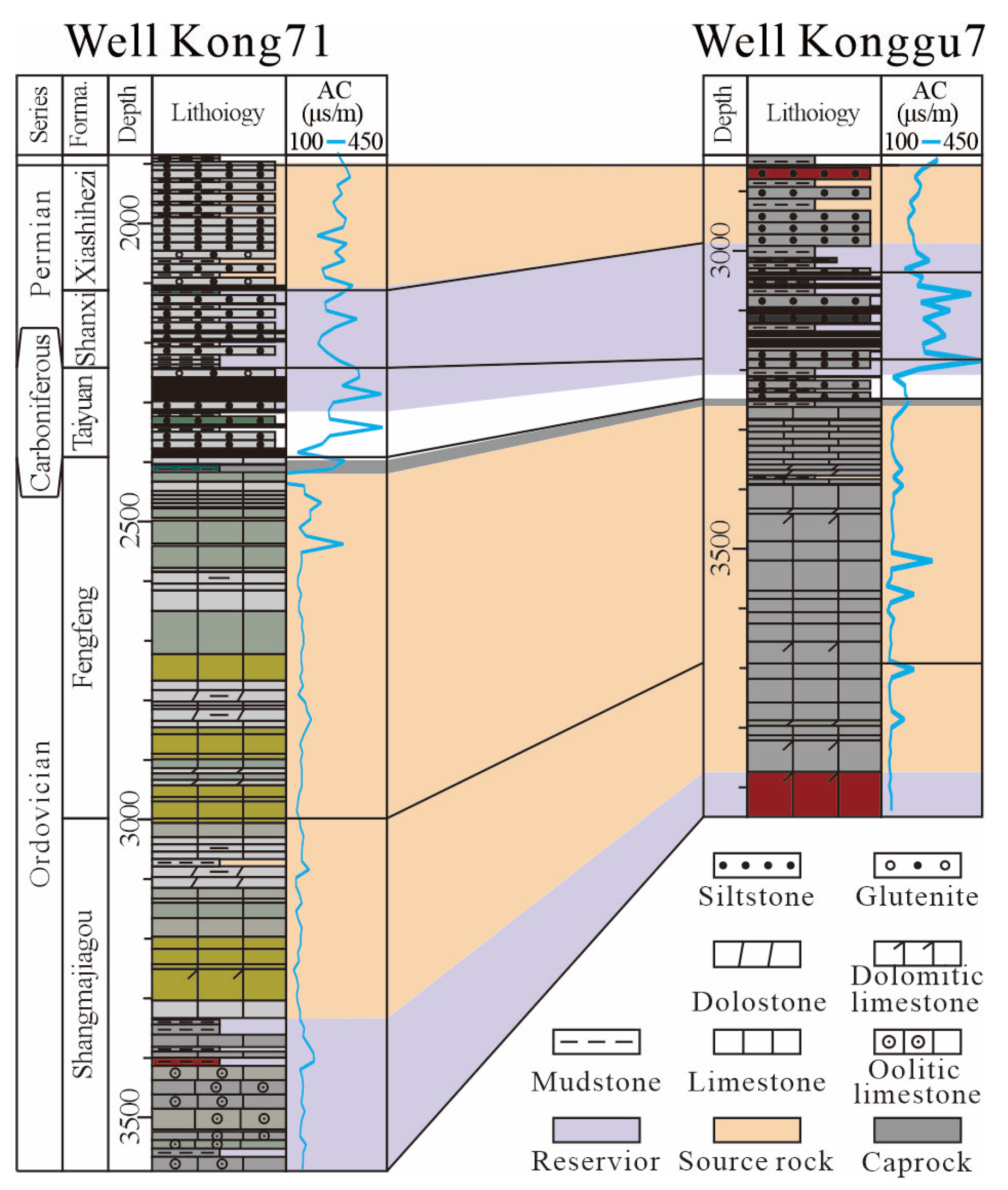
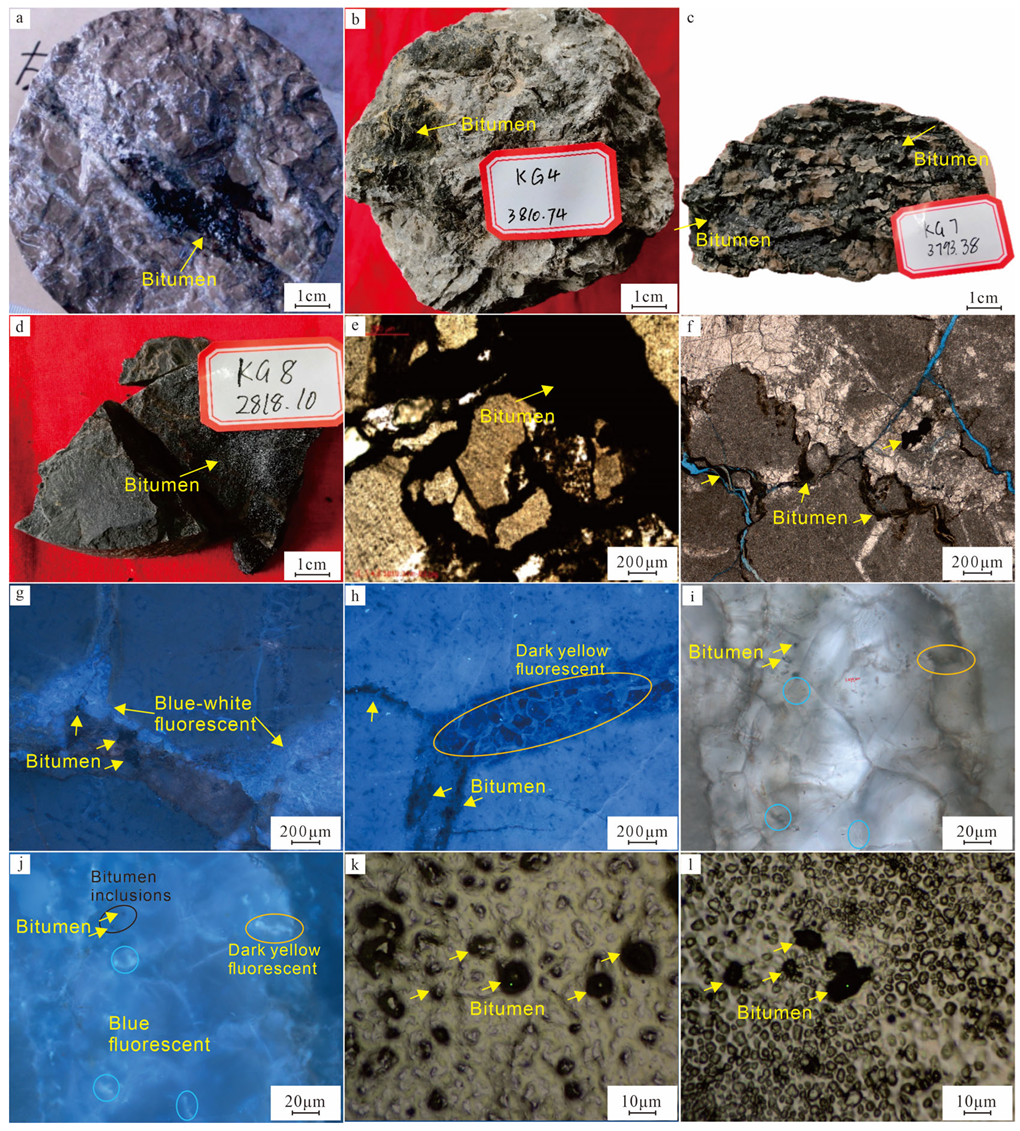

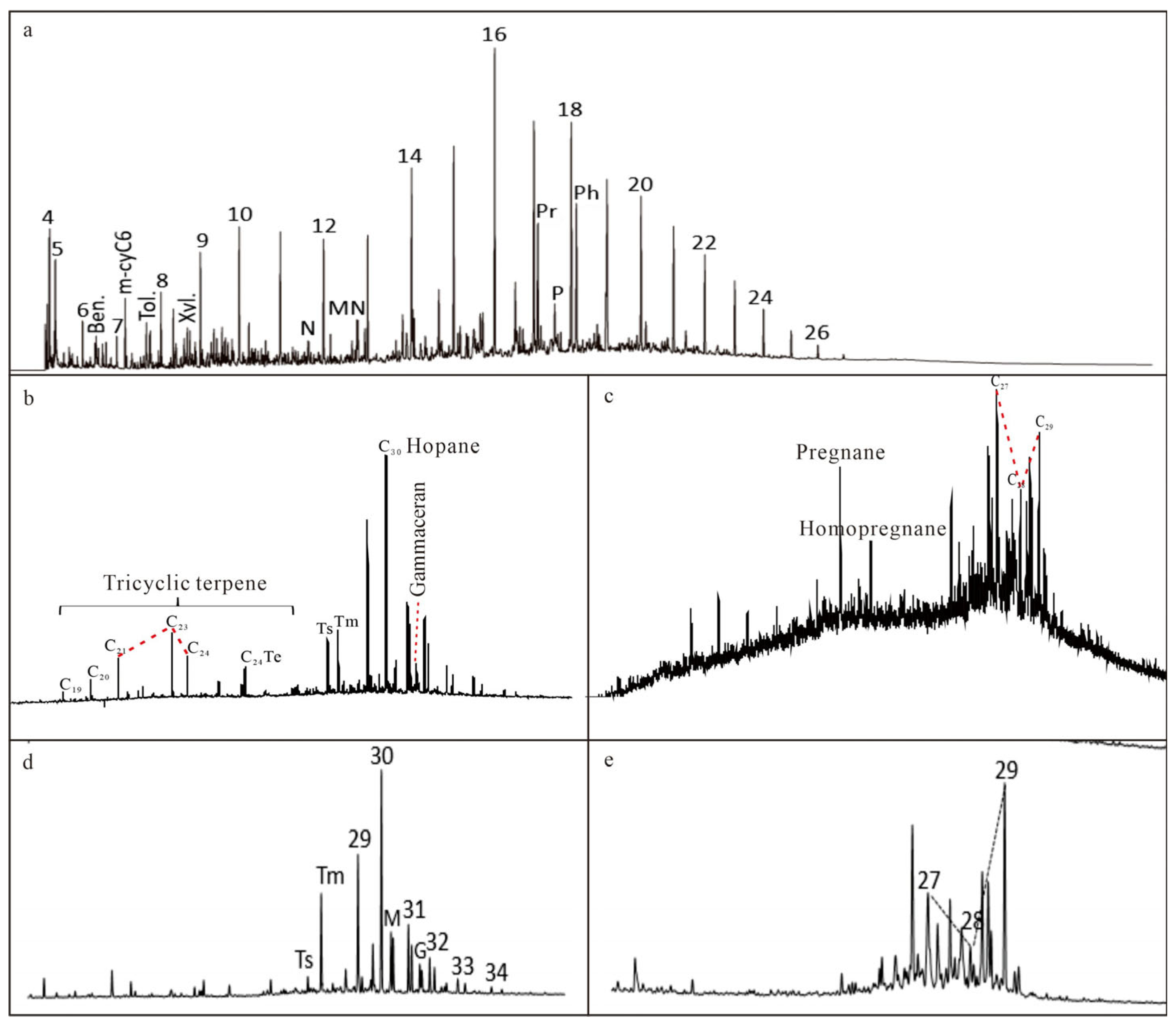
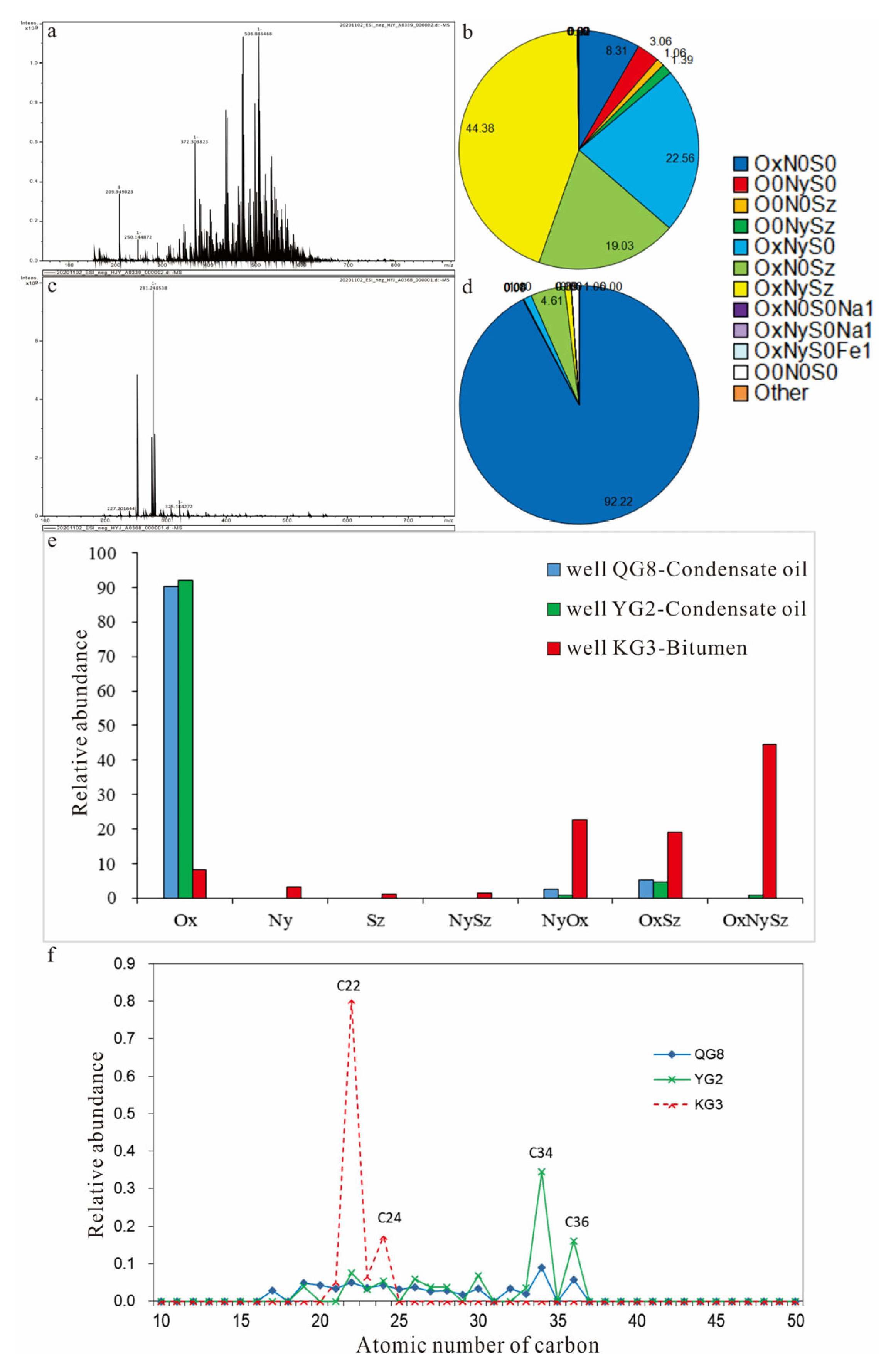

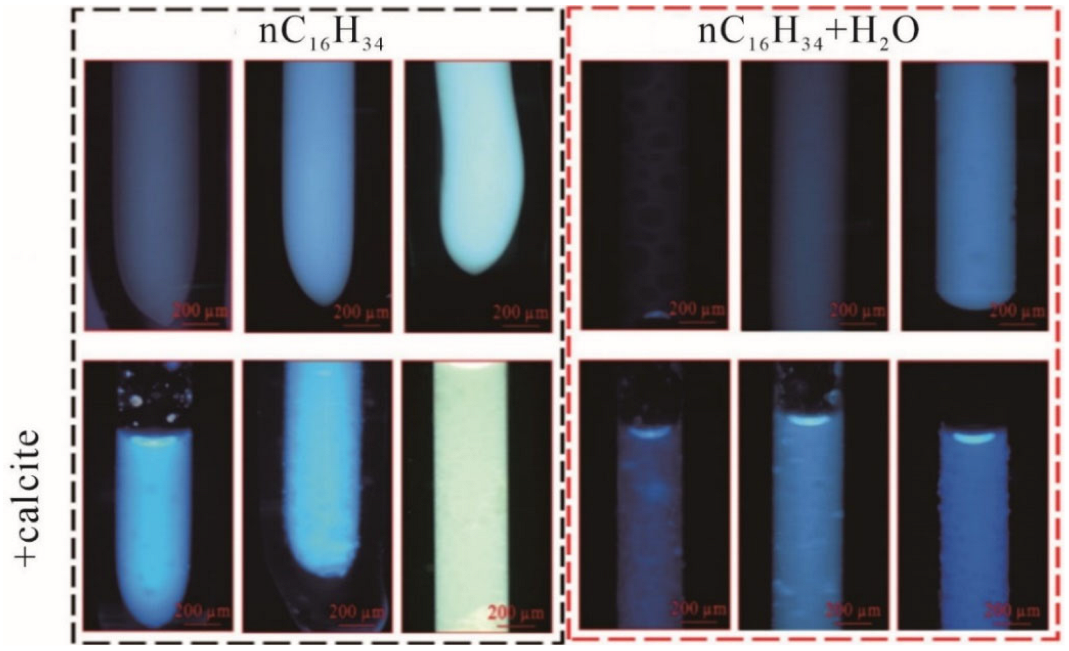

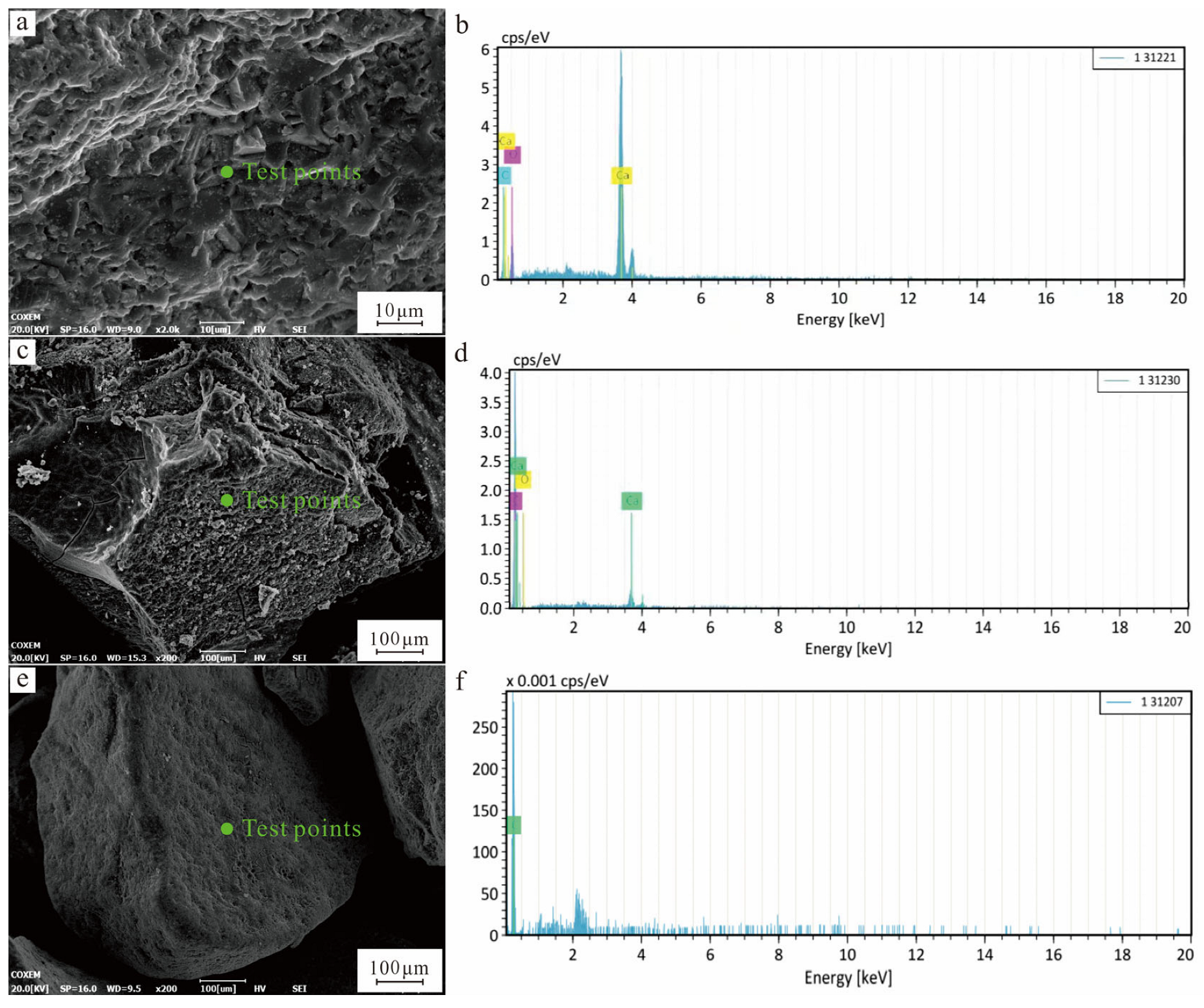


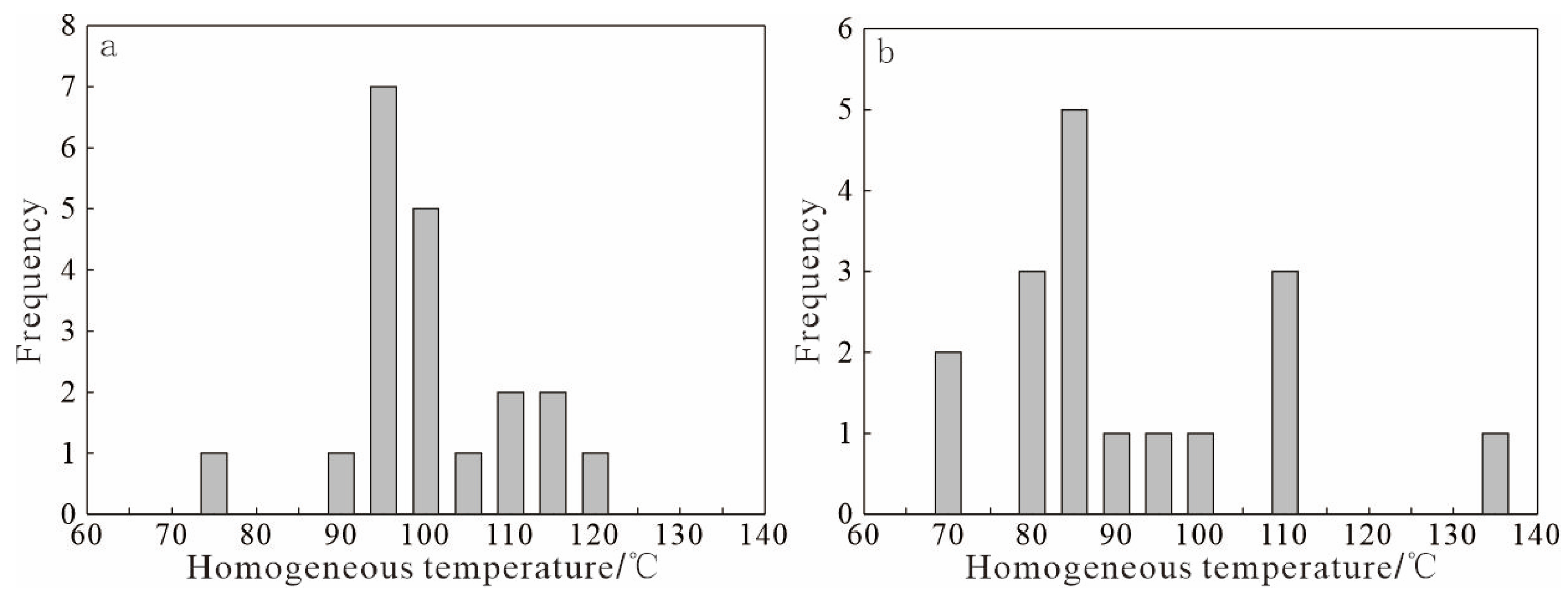
| Well Konggu 7 (Ordovician) | Well Konggu 8 (Carboniferous–Permian) | ||||
|---|---|---|---|---|---|
| Depth (m) | Bitumen Reflectance (Rb) | Number of Testing Points | Depth (m) | Bitumen Reflectance (Rb) | Number of Testing Points |
| 3212.20 | 1.022 | 10 | 2740.10 | 0.536 | 11 |
| 3254.32 | 1.137 | 10 | 2746.20 | 0.548 | 10 |
| 3287.26 | 1.251 | 7 | 2783.30 | 0.561 | 2 |
| 3445.30 | 1.365 | 2 | 2797.41 | 0.573 | 2 |
| 3674.52 | 1.479 | 1 | 20,811.50 | 0.586 | 6 |
| 3694.21 | 1.594 | 5 | 2813.45 | 0.598 | 5 |
| 3716.85 | 1.708 | 10 | 2818.10 | 0.611 | 6 |
| 3842.32 | 1.822 | 2 | 2928.32 | 0.623 | 4 |
| 3942.15 | 1.937 | 10 | 2936.20 | 0.636 | 3 |
| 3940.24 | 2.051 | 1 | 2936.54 | 0.648 | 1 |
Disclaimer/Publisher’s Note: The statements, opinions and data contained in all publications are solely those of the individual author(s) and contributor(s) and not of MDPI and/or the editor(s). MDPI and/or the editor(s) disclaim responsibility for any injury to people or property resulting from any ideas, methods, instructions or products referred to in the content. |
© 2025 by the authors. Licensee MDPI, Basel, Switzerland. This article is an open access article distributed under the terms and conditions of the Creative Commons Attribution (CC BY) license (https://creativecommons.org/licenses/by/4.0/).
Share and Cite
Lou, D.; Cao, Y.; Han, X. Bitumen Characteristics, Genesis, and Hydrocarbon Significance in Paleozoic Reservoirs: A Case Study in the Kongxi Slope Zone, Dagang Oilfield, Huanghua Depression. Minerals 2025, 15, 443. https://doi.org/10.3390/min15050443
Lou D, Cao Y, Han X. Bitumen Characteristics, Genesis, and Hydrocarbon Significance in Paleozoic Reservoirs: A Case Study in the Kongxi Slope Zone, Dagang Oilfield, Huanghua Depression. Minerals. 2025; 15(5):443. https://doi.org/10.3390/min15050443
Chicago/Turabian StyleLou, Da, Yingchang Cao, and Xueyu Han. 2025. "Bitumen Characteristics, Genesis, and Hydrocarbon Significance in Paleozoic Reservoirs: A Case Study in the Kongxi Slope Zone, Dagang Oilfield, Huanghua Depression" Minerals 15, no. 5: 443. https://doi.org/10.3390/min15050443
APA StyleLou, D., Cao, Y., & Han, X. (2025). Bitumen Characteristics, Genesis, and Hydrocarbon Significance in Paleozoic Reservoirs: A Case Study in the Kongxi Slope Zone, Dagang Oilfield, Huanghua Depression. Minerals, 15(5), 443. https://doi.org/10.3390/min15050443





